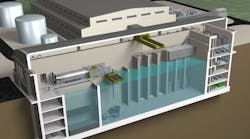NRC Final Approval Moves NuScale's Nuclear SMR Design Closer to On-site Reality
The first-ever small modular reactor design approved by the U.S. Nuclear Regulatory Commission may now move, slowly, into the project phase that could offer carbon-free baseload power options for the future utility, commercial and industrial sectors.
The Federal Register published several days ago cited the NRC has having certified the NuScale Power SMR design that will open it up to licensees which want to locate a small reactor. The final rule is effective on February 23.
Among those considering SMR nuclear, which vary from 50 to 80 MW per reactor unit, would include utilities, data centers and other entities trying to embrace net zero goals but concerned about the intermittencies of renewables and energy storage.
“NuScale is the first small modular reactor design reviewed by the NRC,” reads the entry in the Federal Register. “NuScale is based on a small light water reactor developed at Oregon State University in the early 2000s. It consists of one or more NuScale Power. A power module is a natural circulation light water reactor composed of a reactor core, a pressurizer, and two helical coil steam generators located in a common reactor pressure vessel that is housed in a compact cylindrical steel containment. The NuScale reactor building is designed to hold up to 12 power modules.”
Oregon-based NuScale Power has forged several partnerships through the years while it applied for and awaited federal approval by the NRC. Earlier this year, a key committee of the Carbon Free Power Project (CFPP) reaffirmed its commitment to the NuScale SMR power plant that will be installed at the Idaho National Laboratory (INL) near Idaho Falls.
The INL has intently studied the high capacity-factor benefits of nuclear power and advocated for its re-emergence as key baseload and emissions-reduction resource. It hopes to have the first SMR module in operation by 2029.
Conventional nuclear currently accounts for about 20 percent of the U.S. electricity generation resource mix, as well as more of half of the grid’s carbon-free power, but projects are tremendously expensive, such as the $30 billion or so being spent to add two units at Vogtle power station in Georgia.
The Carbon Free Power Project SMR would include six, 77-MW modules to generate 462 MW total, according to NuScale press release about the INL site.
“The CFPP remains on schedule and is a cost-competitive, carbon-free and dispatchable resource that is an important part of a diversified resource portfolio,” the company said in the statement.
The INL’s CFPP, in which NuScale is also partnering with off-taker Utah Associated Municipal Powers Systems, is aiming for an initial target price of about $89 per MWh, according to the statement.
The report released a year ago by the U.S. Energy Information Administration estimated the levelized cost of energy for wind, solar and gas-fired combined cycle power relatively close to each other at near $30 to $50 per MWh. Those costs are calculated as dropping for renewables over a 30-year cost-recovery period, according to the EIA.
NuScale Power, meanwhile, in the past year alone has signed future partnership agreements or memorandums of understanding with companies as diverse as Shell, Samsung, Doosan, GS Energy and Dairyland Power Cooperative.
Rod Walton, senior editor for EnergyTech, a sister brand of T&D World, is a 15-year veteran of covering the energy industry both as a newspaper and trade journalist. He can be reached at [email protected].


